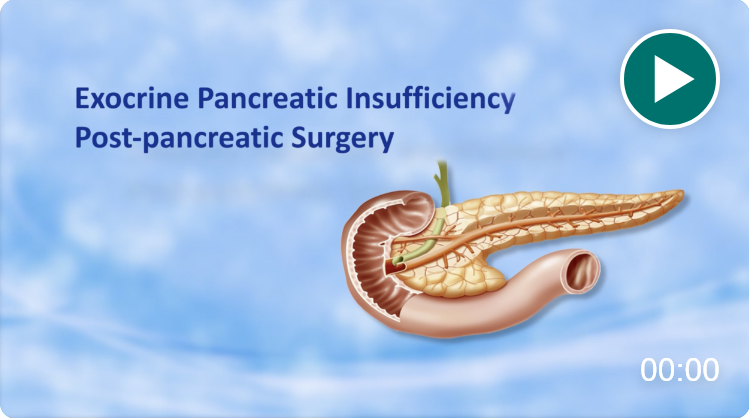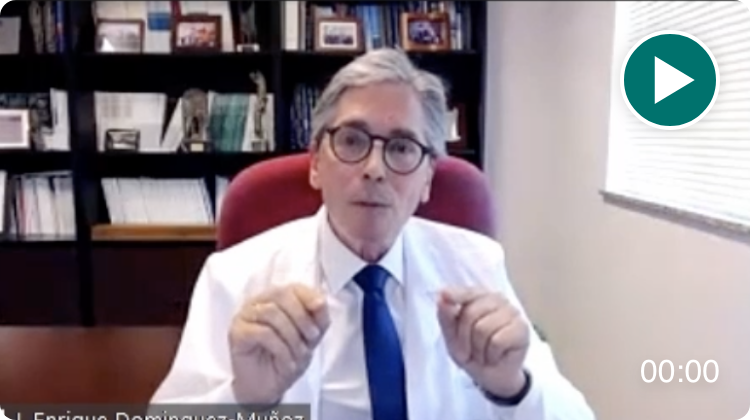
EPI Education
Take a deep dive into EPI and learn from experts in the field.
About EPI: EPI pathogenesis, symptoms, and diagnosis
Etiologies of EPI: Recognize EPI and the barriers to diagnosis
Management of EPI: Key information for managing EPI
Case Studies: Experts present case-based narratives on EPI
Select one or more filters below to explore topic-specific resources.
Transcript
So, this is my case study. Actual patient that we saw in our clinic for diagnosis of pancreatic cancer. Sixty-year-old male diagnosed with diabetes about three years ago. The incidence of diabetes and pancreatic cancer is a little over 60 percent. So, it's not uncommon when you meet a patient with pancreatic cancer that they also have diabetes.
Reported GI symptoms to his primary care physician three months ago, loose stools up to six times per day. Presented to his emergency department painless jaundice. So, it's probably the head of the pancreas. Dark urine, loss of appetite, abdominal distension, and about a 20-pound weight loss. So, came with a diagnosis of pancreatic cancer. A large mass, head and neck of the pancreas, 360 encasement of the superior mesenteric artery and the celiac axis. He went endoscopic biliary stenting.
So, this guy, unfortunately, continued to have weight loss. Additional 5 pounds lost in the past week. Diarrhea, six to eight times per day. Foul-smelling stools, early satiety, discomfort after eating, and bloating and gas.
So, when I walk into that room to meet that newly diagnosed pancreatic patient, from a nutritional standpoint, they can have any or all of these symptoms that can contribute to weight loss. So, they'll tell you, and the family will agree or may comment if the patient doesn't, that they're eating significantly less. That there may be discomfort with eating. There could be pain. There can be a new diagnosis of diabetes at the onset of having pancreatic cancer. If you can imagine that. So, 85 percent of these patients are malnourished.
When I see them at the diagnosis, 90 percent have had some weight loss. So, it's not unusual to talk to a patient who will describe, "Well, I thought I was trying to have intentional weight loss, but it started to come off really quickly and I didn't do a thing." So, you really want to get a good idea of their weight history when you do talk to them. How soon did they lose that weight? And, of course, malabsorption will add to that picture of weight loss. So, you also want to be able to identify that.
We're pretty aggressive when we see these patients as dietitians and providers that work with these patients because we do want to stop the weight loss, and we want to be as aggressive as we can in symptom management. And that involves the team to be able to palliate their pain. To identify malabsorption. To see what they're eating and what they can’t eat. To correct their constipation or diarrhea. So, we work very hard. It's very gratifying to work with these patients because you can make a difference, especially as a team.
But the consequences of cachexia when patients continue to have weight loss, the worsened post-operative outcomes, reduced treatment tolerance. So, if I'm following a patient who embarks on a course of radiation and chemotherapy, and they begin to lose weight, and they become more symptomatic to the toxicities of treatment, what happens is that the oncologist or the team, the radiation oncologists, may give that patient a treatment break, or they may reduce their chemo, or they may change them to a second or third line of chemotherapy that may not be as effective. So, they become more responsive to the symptoms that they are having from their disease, and we don't want that to happen. So, of course, they can have a decreased quality of life, more progressive disease, higher rates of metastatic disease, and reduced survival.
So, it's interesting when you look at survival and weight loss. When you talk to patients and the extent of weight loss, sometimes providers don't really pay attention to that. "Oh, it was 5 percent. Well, that's okay." Ten percent sometimes gets their eyeballs rolling. That gets their attention.
But look what the impact that it has on survival, and this is in pancreatic cancer. So, a weight loss of greater than 5 percent or less than or equal to 10 percent of total body weight, a 3.9-fold higher relative risk of death than those without weight loss. Weight loss greater than 10 percent of total body weight, a seven-fold higher relative risk of death. So, that's why we act very quickly in seeing these patients. There's not a delay to helping them.
In terms of also staying on the survival track, which is important for these patients. This was a prospective trial included about 194 patients with advanced pancreatic cancer. And they were trying to find if there was a correlation with a fecal elastase test and survival. And they compared, they were looking at the cumulative overall survival in months from diagnosis, and they looked at the fecal elastase scores. And those patients that had a fecal elastase score of less than or equal to 20 had a median survival of about seven months, compared to eleven months in those that had greater than 20. This is interesting because it was shown to be an independent predictor of survival.
The NCCN Guidelines are some governing guidelines that cancer centers use in the treatment and management of cancers. And in particular to pancreatic cancer, there's a notation about addressing the problem of EPI. And a special impact that assessing and managing that can have an impact on quality of life.
So, I look at the red flag and best practices, and I say, if it's a pancreatic cancer patient, the red flags all over that person. Regardless if they're asymptomatic when you meet them, along the line of treatment, if they go to surgery, you can bet they're going to have some issues with nutrition. So, it's really critical that you meet these patients early on versus later because so much can happen with these patients.
In fact, at Dartmouth, I see them at diagnosis. I’ll continue to follow them throughout their treatment course because treatment can change. They can have different array of symptoms with treatment changes.
It's really incredibly important that they maintain their weight as best as possible. You're assessing for malabsorption, which is kind of hard to tease out if they’re also on treatment because some of the treatment that they get may contribute to diarrhea, may contribute to increased gas and bloating. So, weeding that out is important.
Thankfully, I've got a great team that also recognizes that malabsorption can be an issue for these patients. I even have the social worker coming to get me and saying, "Jeannine, I think there's a problem with this patient." They're having a lot of light-colored stools, foul-smelling stools. We always described the foul-smelling stools as if it drives the dog away, then it's pretty malodorous. But a reassessment of malabsorption while they're on treatment, symptoms. If they're having constipation with pain therapies that may be complicating your assessment of malabsorption.
And then the education piece about EPI signs and symptoms. When I meet a patient, pancreatic cancer patient for the first time, I am telling them, I'm educating them and the caregivers about this because I am going to continue to assess for it, from the day I meet them on through treatment. And it's really important. I don't have all my patients keep a diary, but I do have some patients that will get the iPad out and record their bowel movements.

EPI in Unresectable Pancreatic Cancer: A Case Study
Recognize the onset of other conditions and deficiencies in pancreatic cancer patients with EPI.

Take an immersive journey into the physiology of the exocrine pancreas and the pathophysiology of EPI.

















